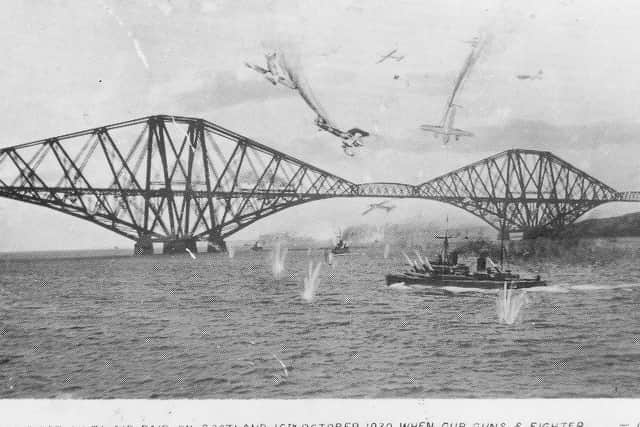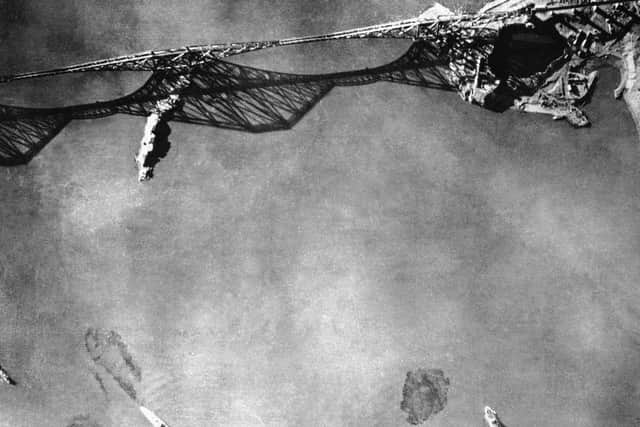Battle of the River Forth: The day World War Two started for real in skies over Edinburgh
and live on Freeview channel 276
But nine months earlier, 80 years ago today, the iconic fighters took part in the first air battle of the Second World War over British skies in a furious but little-remembered skirmish over Edinburgh and the Forth which killed sixteen Royal Navy sailors and injured 44 more.
The Battle of the River Forth, on October 16, 1939, the first Luftwaffe air raid on Britain, was later referred to as a “dress rehearsal” for the Second World War by an RAF officer.
Advertisement
Hide AdAdvertisement
Hide AdTwelve German bombers – Junkers Ju 88s – flew over East Lothian to the Firth of Forth.


Their target was the pride of the British fleet, battlecruiser HMS Hood, which they believed was anchored in the estuary.
Official German intelligence was that there were no Spitfires in Scotland, so when the Luftwaffe spotted a large British battleship in the Forth during a reconnaissance mission that morning, they hastened to the attack.
The attack took the British air force by surprise, and RAF fighters at first thought the Red Alert was just another training drill.


Advertisement
Hide AdAdvertisement
Hide AdNo air raid was sounded, which caused serious concern over the early-warning system in the following days, and an investigation was later launched by the Ministry of Home Security.
The mystery was deepened by the fact that there were sirens in some places and not others – in Perth, which was not threatened at all, residents were kept in shelters for several hours.
Pieces of anti-aircraft shells fell across the city, but just four civilian casualties were reported.
One mother in the east of the city heard the planes and rushed into the garden to bring her child, who had been in a pram outside, out of danger.
Advertisement
Hide AdAdvertisement
Hide AdWhen she later went to retrieve the pram she found a machine-gun bullet through the bottom of it.
The German attack was led by commanding officer Helmuth Pohle and second-in-command Hans Storp.
Storp’s aircraft was shot down off Port Seton, the first German aircraft brought down over Britain since World War One.
The final engagement was between a Ju 88 and two Spitfires over Portobello Beach.
Advertisement
Hide AdAdvertisement
Hide AdEyewitness Richard Demarco, now 89, was on the beach with his younger brother.
“The noise of the engines was deafening, and so was the rat tat tat of the bullets from the Spitfire,” he said.
“The bomber was in its death throes, and the left-hand side engine was on fire, it looked like a dragon coming towards me.”
Bullets from the Spitfire came blasting into the wet sand at the future art impresario’s feet, missing him by inches.
“It was a miracle I was not shot dead,” he added.
Advertisement
Hide AdAdvertisement
Hide AdThe plane, piloted by Captain Pohle, plunged into the water about five miles off Crail. Pohle survived, while crew Kurt Seydel and August Schleider were killed, and Werner Weise was reported Missing in Action.
There were no RAF casualties.
The 603 Squadron, which remains a unit to this day, gathered on October 14 this year to mark the 94th anniversary of the unit’s formation and celebrate its achievements, including at the Battle of the River Forth.
Flight Lieutenant Ross McElhinney said: “This is a very important moment in the history of 603 Squadron, and one that we are immensely proud of to this day.
"The pilot who shot down the German aircraft – Flt Lt Pat Gifford – was a volunteer member of the Auxiliary Air Force before the war, he was originally a solicitor in Castle Douglas. This didn’t stop him volunteering his skills to support the call of duty.
"His section, with support from 602 (City of Glasgow) Squadron, performed to the highest levels on that important day; drawing on their skills, training and grit."
